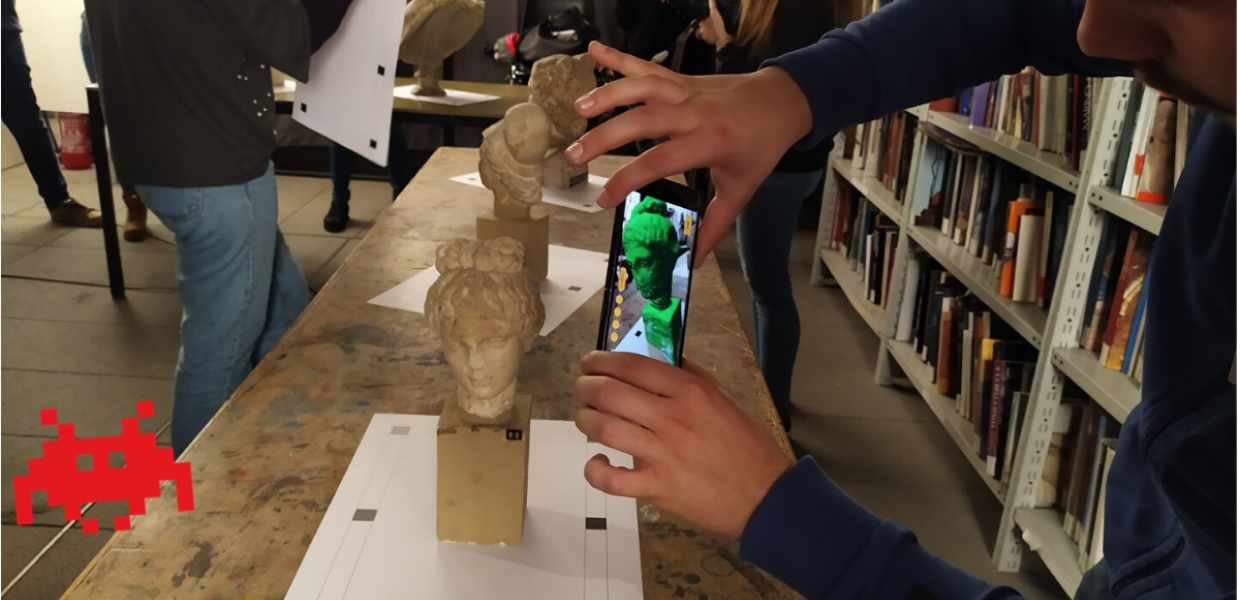Bringing 3D into Digital Invasions
The advent of 3D technology is bringing new opportunities for the cultural heritage sector, offering innovative ways to provide access to heritage for education, tourism, research and enjoyment. However, it also throws up new challenges - how best to embrace 3D given access to new technologies and the speed of technological change? In this post, we hear about how Invasioni Digitali (Digital Invasions) - a crowdsourcing initiative which aims to promote the value of and engagement with local heritage - has made 3D a feature of ‘invasions.’

- Title:
- Students during the 3D Digital Invasions at the Civic Museum of Castello Ursino in Catania, Sicily
- Creator:
- Prof. Cettina Santagati
- Country:
- Italy
- Copyright:
- CC BY-SA
About Digital Invasions
Italy has 4,908 museums, archaeological areas, monuments and ecomuseums. In one Italian municipality out of three (2,311) there is at least one museum: one for every 50 sq km and one for every six thousand inhabitants. But despite the progressive diffusion and application of digital technologies in the museum world, in Italy only one museum out of ten (10.4%) has created a digital catalogue of their content. Only one third (37.4%) has already completed the digitisation process, while two thirds have begun these activities but have covered about 50% of the goods and collections available (Source Istat, ‘L’Italia dei musei 2018’).
Invasioni Digitali was born to respond to such a situation, with our first event taking place in April 2013. Social and digital communication are the key to the invasions: ‘invaders’ are bloggers, amateur archaeologists, artists, photographers, Instagrammers, communication experts and members of the public, all with the same desire to promote their cultural heritage through social media. They support Italy’s cultural institutions by ‘invading’ them with cameras, smartphones and tablets and share their cultural experiences through the web and social media. To date, over 2,500 invasions have been organized - including one at Europeana 2019 - and about 50,000 people have been involved across multiple countries. Nearly 52,000 pictures on Instagram and over 100,000 tweets with the tag #invasionidigitali have been shared.
#InvasioniDigitali has become a popular example of users’ involvement and proactive participation in co-creation, sharing and dissemination of cultural content, creating new forms of conversation about arts and culture and helping to make cultural heritage open, welcoming and innovative.
Bringing 3D into Digital Invasions
The creation of virtual replicas has become an important emerging area within cultural heritage: 3D models can become a bridge between original artwork and people from different backgrounds. They can be particularly valuable for people with visual impairments, allowing a ‘Don’t touch’ sign to be replaced with an invitation to touch the art. 3D technology can help recreate pieces of art to help everyone enjoy them.
3D #DigitalInvasions was a pilot experiment that took place in Sicily in 2015. We involved engineering students from Palermo and Catania Universities in planned invasions in the Antonino Salinas Archaeological Museum (Palermo) and the Archaeological and Naturalistic Park of Santa Venera al Pozzo in Acicatena (near Catania). Students created 3D digital replicas of several archaeological works. They used image-based techniques to obtain 3D textured models of an object, sourced from an appropriate photo dataset taken from cameras, smartphones and tablets. The 3D models were then given to the involved public administrations.
During these first two 3D Digital Invasions editions we developed the belief that our approach could also be applied to other sectors of cultural heritage, using technology to spur innovation in museums. We were also interested in exploring how students were able to develop a sense of identity and affiliation to the cultural heritage they worked on. They spent a lot of time capturing the images, giving them the chance to observe, study and understand a piece of art, rather than quickly take a photo and pass to another. This approach aimed to allow them to be personally involved in a specific process to create user generated content and increase an artwork’s cultural value in its own context.
We have continued to run 3D digital invasions with a focus on student participation. In early 2019, the Faculty of Architecture of the Sapienza University of Rome also joined the #InvasioniDigitali 3D, and organised a workshop around the theoretical foundations of photography and digital photogrammetry. These techniques were then used for photography of the sculptural collections preserved in the Museum of Classical Art which is part of the University Museum System. The models obtained by students at the Museum of Classical Art, are available through Sketchfab. We also ran a 3D digital invasion with students from the ‘Automatic Design-Digital Survey’ course from the Faculty of ‘Building Engineering-Architecture’, Department of Civil Engineering and Architecture of the University of Catania later in 2019, and, more recently, in February 2020 a further workshop with students of the Faculty of Architecture of the Sapienza University of Rome.

